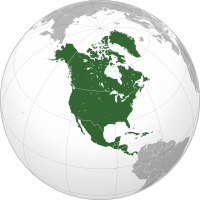North-America
 |
|
| Area | 24,709,000 km2 (9,540,000 sq mi) |
|---|---|
| Population | 565,265,000 (2013, 4th) |
| Population density | 22.9/km2 (59.3/sq mi) |
| GDP (nominal) | $21.2 trillion (2016, 2nd) |
| GDP (PPP) | $37.4 trillion (2016, 1st) |
| Demonym | North American |
| Countries | 23 |
| Dependencies | 22 (see list of countries) |
| Languages | English, Spanish, French, and many others |
| Time zones | UTC-10 to UTC |
| Largest cities |
Largest urban areas: Mexico City New York City Los Angeles Chicago Toronto Dallas–Fort Worth San Francisco Houston Miami Philadelphia |
North America is a continent entirely within the Northern Hemisphere and almost all within the Western Hemisphere. It can also be considered a northern subcontinent of the Americas. It is bordered to the north by the Arctic Ocean, to the east by the Atlantic Ocean, to the west and south by the Pacific Ocean, and to the southeast by South America and the Caribbean Sea.
North America covers an area of about 24,709,000 square kilometers (9,540,000 square miles), about 16.5% of the earth's land area and about 4.8% of its total surface. North America is the third largest continent by area, following Asia and Africa, and the fourth by population after Asia, Africa, and Europe.
In 2013, its population was estimated at nearly 565 million people in 23 independent states, or about 7.5% of the world's population, if nearby islands (most notably the Caribbean) are included.
North America was reached by its first human populations during the last glacial period, via crossing the Bering land bridge. However, more recent studies, in April 2017, suggest that ancient humans were present on the North American continent 130,000 years ago, much earlier than 15,000 years ago, thought previously based on genetic studies. Nevertheless, the so-called Paleo-Indian period is taken to have lasted until about 10,000 years ago (the beginning of the Archaic or Meso-Indian period). The Classic stage spans roughly the 6th to 13th centuries. The Pre-Columbian era ended with the transatlantic migrations and the arrival of European settlers during the Age of Discovery and the Early Modern period. Present-day cultural and ethnic patterns reflect different kind of interactions between European colonists, indigenous peoples, African slaves and their descendants. European influences are strongest in the northern parts of the continent while indigenous and African influences are relatively stronger in the south. Because of the history of colonialism, most North Americans speak English, Spanish or French and societies and states commonly reflect Western traditions.
...
Wikipedia
